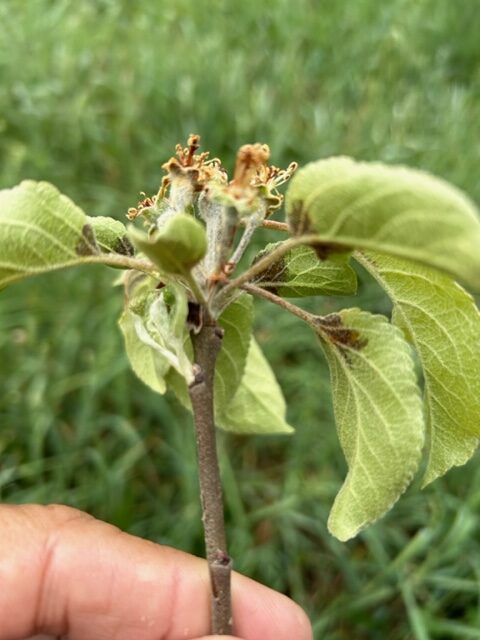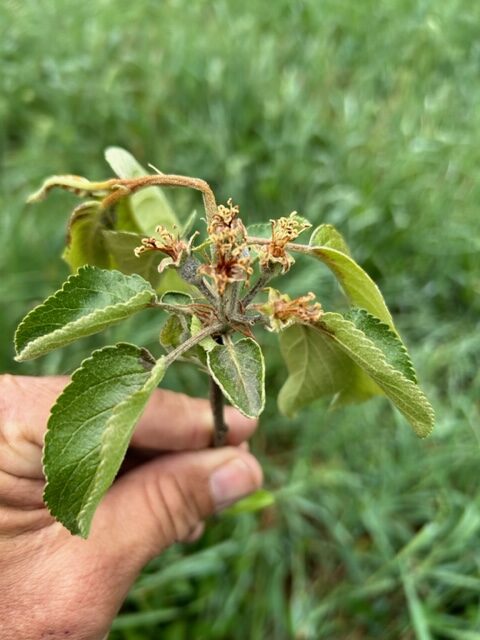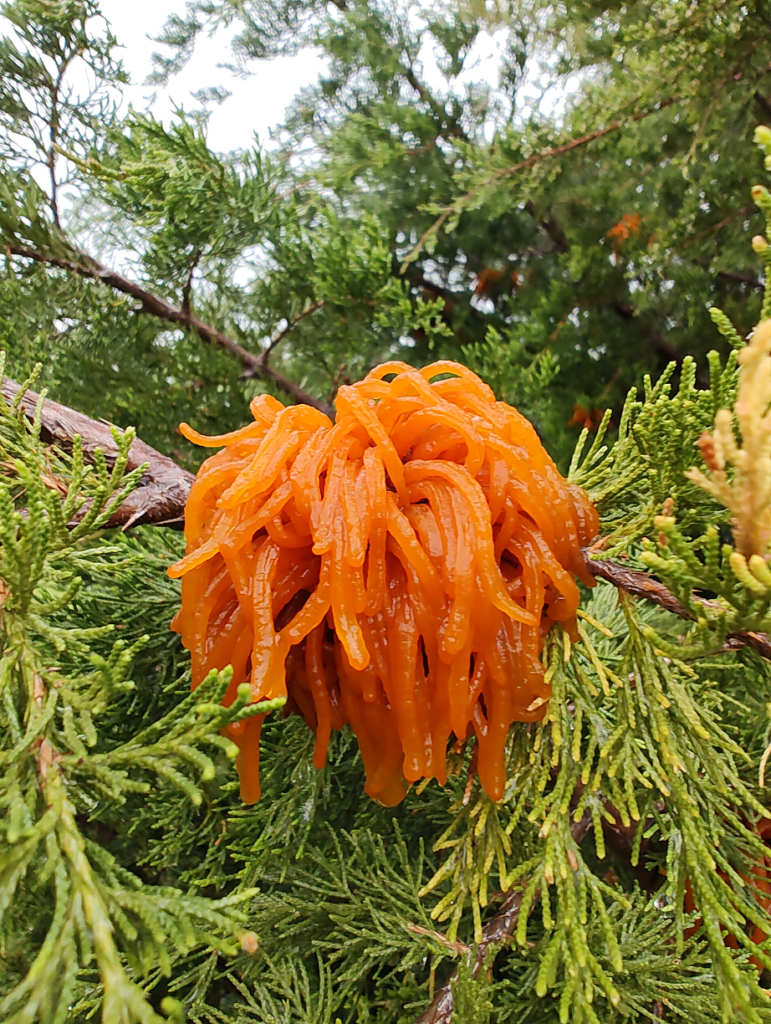1. First Fire Blight Symptoms on Flowers Visible in Winchester; 2. Cedar Apple Rust Galls Fully Developed and Basidiospores Infecting Unprotected Apple Trees
1. On 29th April, first blossom blight symptoms were found by Bill Mackintosh (Figs 1, 2). Most likely these infections of flowers have established either on the 5th or 6th April or 16 or 17 April, with the latter being the more likely scenario as we were at full bloom 13-15 April at AREC on Fuji. In cases where unfortunately you see 1 to 5% or more blossom blight symptoms, you have active infections taking place on actively growing shoots. If you soon see fire blight strikes (flags), assume that the fire blight bacterium will be probably be present for a long time in your orchard and you will be at a high risk from when the first flower open until terminal bud set on shoots in future years. You will require protection of flowers each spring when models like Maryblyt or EIP in NEWA predict infections risks. If you see fire blight symptoms do not apply streptomycin as the bacterium is in the tissue, so it cannot be reached by the antibiotic, and there is a risk that if you do you will promote streptomycin resistance acquisition in the fire blight bacterium Erwinia amylovora. This will reduce efficacy of this antibiotic, or even worse, lead to the loss of its efficacy through resistance.


Figures 1 and 2 showing first symptoms of blossom blight in Winchester, VA (Photo courtesy of Mackintosh B. 2023).
At this moment, if symptoms are visible, apply plant growth regulator (PGR) prohexadione-calcium (Apogee, Kudos) to reduce susceptibility of not-yet-infected shoots and slow down the invasion shoots by the fire blight bacterium. This PGR works by inhibiting hormones of growth in the green tissues and thus reduces the vegetative tree growth i.e. shortens the shoot length. More importantly, prohexadione-calcium shortens the period of terminal shoot growth and reduces susceptibility of shoots to fire blight. Because the trees are no longer susceptible to fire blight infections when shoots stop its growth i.e. when terminal buds set on shoots, application of Apogee or Kudos will speed onset of terminal bud formation, thus reducing the period of shoot susceptibility to infection and reducing the chance for spread of fire blight on other shoots. If symptoms are either few or numerous, meaning 1 to 20 or more blighted flower clusters per tree, mature bearing orchards should be sprayed with 12 oz of Apogee per 100 gal, preferably in a dilute spray, to get a good coverage of all shoots. This will help reduce the number of fire blight cankers developing on wood by invasion from infected flowers and shoots. Management should also include spraying a copper material at 0.2 lb/A of metallic copper equivalent (if slow drying conditions were highly likely to occur after this application, as even this low dose could cause fruit russetting at slow drying conditions). After the copper spray work on fire blight symptom removal. Copper will only kill fire blight bacteria present in bacterial white, yellow or orange ooze droplets visible on the surface of both blighted and freshly infected flower cluster leaves, flowers, and shoots (Fig. 1).
Droplets of fresh bacterial ooze, which spread this bacterium to uninfected green tissues, emerge on infected green tissues much before the fire blight symptoms are visible. This means that bacteria usually have ample time to extensively spread to the surrounding, uninfected clusters and shoots before the first shoot strikes are visible. Due to recommended low copper doses and the fact that copper does not kill bacteria inside the infected tissues, the effect of copper will be to slow down or prevent further spread of pathogen to new, uninfected shoots. More spray applications may be needed to achieve desired effect. High rates of copper and copper applied just before wet and slow-drying conditions could injure fruit skin up through at least mid-June Cultivar differ in their susceptibility to copper related russetting You will need to take into account how prone is each of your cultivars to russetting by copper, watch the weather forecast to avoid applying copper before wet and slow drying conditions, and apply low-doses of copper probably multiple times with lower water volume (to promote quick drying after spray). When considering use of copper, a tank mix of Cueva and Double Nickel might be the best choice since there are some indications that this mix may be less prone to cause fruit russetting.
If possible, remove fire blight symptoms as soon as they appear, after you applied Apogee or Kudos. Cutting out the infected strikes at 18 to 24 inches below the visible margin of infection on dead shoots or flowers aims to remove bacteria that might have penetrated into the symptomless wood far below the infection margin. If these length requirements below symptom edge could not be met, pruning should be done into the closest perennial wood (at least 2-yr-old, and 4-6 inches into this wood if possible). Prune on a cool dry day and never before, during or soon after rain of heavy dew. These conditions will risk spreading fire blight more. All pruned out brush should be left on the ground close to the tree and flail-mowed or removed from the orchard after the branches are completely dry (cuts show no green cambium visible when bark is scraped with a knife). If there is enough space in the mid-rows to leave the brush on the ground, without preventing passage of air-blast sprays with a tractor, copper could also be applied after pruning. During symptom removal, pruning tools should be disinfected at least between each tree with 70% rubbing alcohol or 10% bleach solution. Even though the true benefit of using any specific disinfectant for tools is still debated or questioned, I would recommend using one of these disinfectant solutions. If pruning is done rapidly, as soon as first symptoms occur, continue daily scouting after the first pruning to remove any additional strikes that develop subsequently.
2. As we predicted in the previous blog post: Major Apple Scab Infection with Rain Events 28 – 30 April, Along With Cedar-Apple Rust Infections from 26 April, Juniper rusts are viciously active as of the intense rain events of 28 April when the galls fully developed (Fig. 3) and are now releasing basidiospores to infect apple leaves and fruit. You should apply SI aka DMI fungicides like Inspire Super, Cevya, Rally, Sonoma, Topguard, Rhyme or Procure + Manzate Pro-Stick every 14 days for rust control. In between the SI/DMI fungicides apply SDHI fungicides Fontelis, Sercadis, Miravis or Excalia + Manzate Pro-Stick to protect against apple scab and powdery mildew.

